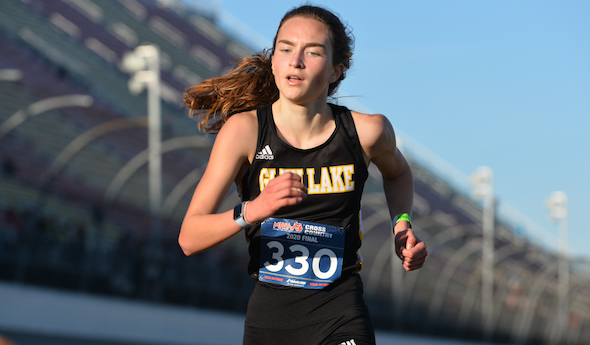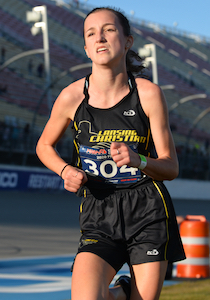
Scott, Pilgrims Finish Championship Chase
November 7, 2020
By Jason Schmitt
Special for Second Half
BROOKLYN – After all the uncertainty of this past fall season, one thing is for sure.
Makenna Scott will be cuddled up with her puppy Milo tonight, gazing fondly at her cross country championship medal.
And who knows, she might even be eating a piece of ice cream cake.
“My parents told me last year that if I got top five I could get my dream puppy, so I got my Bernese Mountain Dog after getting fourth,” said Scott, a junior from Maple City Glen Lake High School. “And this year, they were like, ‘What do you want?’ I told them a state championship, I don’t need anything else — but maybe an ice-cream cake would be nice.”
Scott earned it after besting the field at Saturday’s MHSAA Lower Peninsula Division 4 Girls Cross Country Finals. She moved into the lead down the final stretch and finished in a winning time of 19:30.2.
“As a freshman, I never thought this would be possible,” Scott said. “I’ve worked my butt off this season. I just can’t believe I did it.”
She said all the sacrifices she’s made have paid off. All of her emotions came out after learning she had won the championship.
“The dedication, having to give up time with my friends to make sure I can run. All the times I’ve said, ‘No, I can’t have a sleepover tonight.’ At the time I wondered, is it all going to be worth it in the end,” Scott said. “Just looking back at it, you really have to want it if you’re going to win a state championship.”
Lansing Christian’s Madison Volz, a senior, was the race leader through the first two miles. But as she neared the three-mile mark, her legs gave out on her. She gutted it out and finished 12th overall, earning all-state honors. Her efforts helped the Pilgrims capture the Division 4 team championship with a score of 93 points.
 “She said she wasn’t going to finish the race, but she knew it mattered for the team score, so she just got up and walked it in, which was actually the difference,” her coach, Jonathan Watson said. “If she doesn’t finish, we don’t win.”
“She said she wasn’t going to finish the race, but she knew it mattered for the team score, so she just got up and walked it in, which was actually the difference,” her coach, Jonathan Watson said. “If she doesn’t finish, we don’t win.”
Sophomore Ashlyn Kephart led Lansing Christian with a sixth-place finish. Senior Natalie Tebben was ninth overall, followed by Volz. Also scoring for the Pilgrims were freshman Hope Tebben and junior Mia Judd.
“We had a goal at the beginning of the season,” Watkins said. “We knew we were in it and had a shot. Our girls worked really hard this year — with this as their goal — and so to get there I know is a relief for them.
“It was a fun day to watch them run their race and go after it.”
Kalamazoo Christian was runner-up, finishing with 142 points. Sophomores Aubrey Herder and Hope Zichterman led the way, finishing 18th and 21st overall.
Beal City was third behind strong finishes from junior Rachal Weber (fourth) and sophomores Tailor Onstott (13th) and Kaylee Locke (14th). Mount Pleasant Sacred Heart was fourth, and Hillsdale Academy rounded out the top five.
Individually, Webberville senior Sara Spalding finished runner-up in a time of 19:44.53. She ran in the first of two division races. Ubly’s Maze Gusa was third, while Weber and Buckley’s Aiden Harrand rounded out the top five.
PHOTOS: (Top) Maple City Glen Lake’s Makenna Scott pushes toward the Division 4 individual title Saturday. (Middle) Ashlyn Kephart crosses first for team champion Lansing Christian, coming in sixth overall. (Click for more from RunMichigan.com.)

MHSAA Vault: MIS Rose to Challenges to Host 2020 LP Finals
By
Rob Kaminski
MHSAA benchmarks editor
November 12, 2021
The “MHSAA Vault” features stories from past publications and other documents in the MHSAA Library. This issue takes a look at the MHSAA Cross Country Finals at Michigan International Speedway, which celebrated 25 years in 2020 – although it was an event that nearly didn’t happen last fall …
In 1996, the MHSAA and Michigan International Speedway began a partnership the changed the course of the Lower Peninsula Cross Country Finals – quite literally.
The land in and around the track at Brooklyn would host the Finals for all classes of runners in one place on one day, an annual festival of nearly 2,000 runners competing for the MHSAA’s top honors.
Even skeptics – and there were several among running purists who thought the course was too flat, for example – can’t deny the results.
Finals attendance nearly doubled in that first year, and crowds in excess of 10,000 have enjoyed a day of racing several times, including a record 12,153 in 2011.
Enthusiastic crowds were the norm in recent years, with 11,232 in 2017, and nearly 11,000 in 2018 (10,989) and 2019 (10,873).
In fact, attendance failed to reach at least 8,000 only twice since the move to MIS.
Of course, last year was an exception, when attendance was limited to 1,000 spectators per session due to the COVID-19 Pandemic. Fans also were restricted to the grandstands rather than following the action throughout locations on the course.
To reduce the number of runners in each race, the event was spread over two days, with each Division being run in two separate “sections” with times then combined at the end to determine team and individual champions.
While not ideal, the end result was another year of fantastic efforts at MIS – both from student-athletes and those behind the scenes.
“Even at the last hour, less than a week ahead of the Finals, we were closer to not having the Finals than we were to having them,” said MHSAA Assistant Director Cody Inglis, who coordinates the cross country postseason. “Rumors and challenges of mandated shutdowns, testing and other requirements were being discussed and caused a lot of unknowns. Even at the Regional level, we had schools, Regional courses and hosts shutting down their facilities; we had to relocate four Regionals 48 hours prior to race times. That scenario just could not happen at the Finals level where far more runners and much more travel would be involved.”
Among the many last-minute hurdles was the edict from NASCAR – which owns MIS – that all persons on site be temperature checked upon entry. That meant securing thermometers that were easy to operate in short order, along with personnel necessary to conduct the readings.
The attendance limitations certainly helped to implement the temperature screening, but brought their own issues.
“Limiting spectators was not a popular decision, but it really was the only way to have a race,” Inglis said. “We were taking direction and working with policies and protocols from the MDHHS, the Governor’s office, Lenawee County Health Department, MIS and NASCAR.”
Part of the solution was to utilize the grandstands as a “barrier” between participants and spectators. The reduced number of fans were dispersed over thousands of seats while still allowing them the chance to watch their student-athletes compete.
“It wasn’t the same, it wasn’t easy or perfect, but it was what we had to do to have a race,” Inglis said. “Separating the Finals into two days and different sections also allowed us to spread out the event and limit the number of people on site at any one time. This was a key part of the plan and worked well even though it separated races within a Division.”
The MHSAA, MIS and the cross country community never lost focus of the main goal: a culmination of the season for the student-athletes, who deserved something last year more than ever. And, more than ever, MIS once again displayed its advantage as a venue that could adapt to the fluid nature of the times to pull off the event.
“There were some thoughts of using four different sites, but as we learned during the Regionals, the climate of things was so tenuous from one area of the state to another that we couldn’t be 100-percent certain that there wouldn’t again be last-minute cancelations,” Inglis said. “MIS was wonderful to work and collaborate with, and was the best option to get it done. It was never mentioned once publicly about the possibility of not having the Finals – only how we could best do it under uncharted conditions.”
The moving parts and ever-changing scenarios created more complexity than ever in finalizing a season, but every decision was made with the complete desire to conduct the Finals as close to normal as possible.
“I firmly believe that a finish to the season, no matter the differences in race formatting and fan experience, was something everyone would have taken when the season began in August,” Inglis said.
Indeed, the finish line in Year 25 at MIS might have been the most gratifying of them all.

